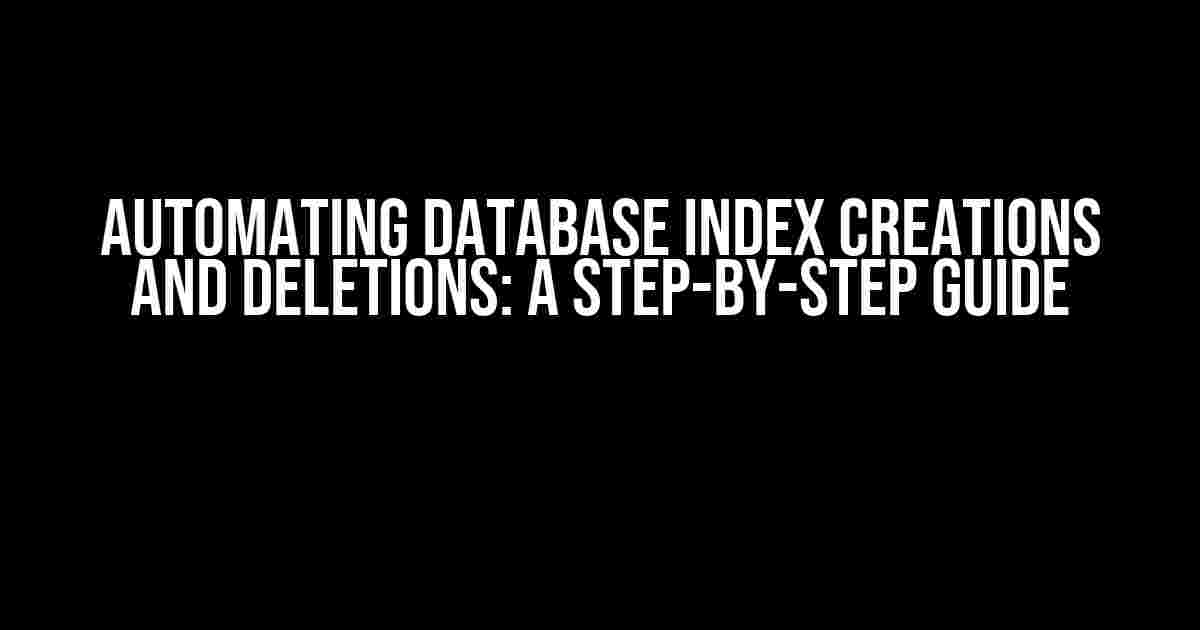As a database administrator, you know how crucial it is to maintain optimal database performance. One often-overlooked aspect of database maintenance is index management. Manual index creation and deletion can be a tedious and error-prone process, especially in large databases. But fear not, dear reader! In this article, we’ll explore the wonders of automating database index creations and deletions, and provide you with a comprehensive guide to get you started.
Why Automate Index Management?
Before we dive into the nitty-gritty of automation, let’s discuss the benefits of automated index management:
- Faster Database Performance: indexes can greatly improve query performance, but poorly maintained indexes can lead to slower performance. Automation ensures that indexes are created and deleted as needed.
- Reduced Database Size: unnecessary indexes can take up valuable storage space. Automation helps eliminate unused indexes, reducing database size and improving overall efficiency.
- Improved Data Integrity: automated index management reduces the risk of human error, ensuring that indexes are created and deleted correctly, and data consistency is maintained.
- Enhanced Scalability: as your database grows, automated index management ensures that indexes are adapted to meet the changing needs of your database.
Tools and Technologies for Automation
To automate database index creations and deletions, you’ll need the following tools and technologies:
- Database Management System (DBMS): choose a DBMS that supports indexing, such as MySQL, PostgreSQL, or Microsoft SQL Server.
- Scripting Language: select a scripting language, like Python, PowerShell, or SQL, to write automation scripts.
- Scheduling Tool: use a scheduling tool, like cron or Task Scheduler, to schedule automation scripts to run at regular intervals.
- Database Monitoring Tool: utilize a database monitoring tool, like Nagios or Prometheus, to track database performance and identify areas for improvement.
Automating Index Creations
To automate index creations, follow these steps:
- Identify Index Candidates: use database monitoring tools to identify columns frequently used in WHERE, JOIN, and ORDER BY clauses. These columns are prime candidates for indexing.
- Write an Automation Script: write a script that creates indexes on the identified columns. For example, using Python and the pyodbc library:
import pyodbc # Connect to the database conn = pyodbc.connect('DRIVER={ODBC Driver 17 for SQL Server};SERVER=your_server;DATABASE=your_database;UID=your_username;PWD=your_password') # Create a cursor object cursor = conn.cursor() # Create an index on the 'column_name' column cursor.execute("CREATE INDEX idx_column_name ON your_table (column_name)") # Commit the changes conn.commit() # Close the cursor and connection cursor.close() conn.close() - Schedule the Script: schedule the script to run at regular intervals, such as daily or weekly, to ensure new indexes are created as needed.
Automating Index Deletions
To automate index deletions, follow these steps:
- Identify Unused Indexes: use database monitoring tools to identify indexes that are not being used or are no longer necessary.
- Write an Automation Script: write a script that deletes the unused indexes. For example, using PowerShell and the SQL Server PowerShell module:
Import-Module SqlServer # Connect to the database $server = 'your_server' $database = 'your_database' $conn = New-Object Microsoft.SqlServer.Management.Common.ServerConnection($server) $conn.LoginSecure = $false $conn.Login = 'your_username' $conn.Password = 'your_password' $conn.DatabaseName = $database $conn.Connect() # Get a list of unused indexes indexes = Invoke-SqlCmd -Query "SELECT name FROM sys.indexes WHERE index_id > 0 AND is_disabled = 0 AND Stats.io_operations > 0" -ServerInstance $server -Database $database # Delete the unused indexes foreach ($index in $indexes) { Invoke-SqlCmd -Query "DROP INDEX [$($index.name)] ON $($index.name)" -ServerInstance $server -Database $database } # Close the connection $conn.Close() - Schedule the Script: schedule the script to run at regular intervals, such as daily or weekly, to ensure unused indexes are deleted and database performance is maintained.
Best Practices for Automated Index Management
To get the most out of automated index management, follow these best practices:
- Monitor Database Performance: regularly monitor database performance to identify areas for improvement and adjust automation scripts accordingly.
- Test Automation Scripts: thoroughly test automation scripts in a development environment before deploying them to production.
- Log Automation Activities: log automation activities to track changes and identify potential issues.
- Review and Refine Scripts: regularly review and refine automation scripts to ensure they remain effective and efficient.
Conclusion
Automating database index creations and deletions is a crucial aspect of maintaining optimal database performance. By following the steps and best practices outlined in this article, you’ll be well on your way to reducing database size, improving data integrity, and enhancing scalability. Remember to regularly monitor database performance, test automation scripts, log automation activities, and review and refine scripts to ensure your automated index management strategy remains effective.
| Tool/Technology | Description |
|---|---|
| Database Management System (DBMS) | A system that manages and provides access to a database. |
| Scripting Language | A language used to write automation scripts, such as Python or PowerShell. |
| Scheduling Tool | A tool used to schedule automation scripts to run at regular intervals, such as cron or Task Scheduler. |
| Database Monitoring Tool | A tool used to track database performance and identify areas for improvement, such as Nagios or Prometheus. |
With automated index management, you’ll be able to:
- Improve database performance
- Reduce database size
- Enhance data integrity
- Increase scalability
Don’t let manual index management hold you back! Automate database index creations and deletions today and take your database performance to the next level.
Frequently Asked Question
Get answers to your pressing questions about automating database index creations and deletion!
What are the benefits of automating database index creation and deletion?
Automating database index creation and deletion can bring numerous benefits, including improved database performance, reduced maintenance efforts, and increased efficiency. By automating these tasks, you can ensure that indexes are created and deleted in a timely manner, which can lead to faster query execution and better overall system performance.
What are the risks of manual database index creation and deletion?
Manual database index creation and deletion can be prone to human error, leading to performance issues, data inconsistencies, and even system downtime. Additionally, manual processes can be time-consuming and may not keep pace with changing database requirements, leading to suboptimal performance and potential security risks.
How can I automate database index creation and deletion?
You can automate database index creation and deletion using various tools and scripts, such as database management systems’ built-in automation features, third-party indexing tools, or custom scripts written in programming languages like SQL or Python. These tools and scripts can help you define indexing rules, schedules, and conditions to automate the creation and deletion of indexes.
What are some best practices for automating database index creation and deletion?
Some best practices for automating database index creation and deletion include defining clear indexing rules, monitoring index performance and usage, scheduling regular index maintenance, and testing automation scripts in a development environment before deploying them to production.
Can I automate database index creation and deletion across multiple databases and platforms?
Yes, it is possible to automate database index creation and deletion across multiple databases and platforms by using universal automation tools or scripts that support multiple database management systems. These tools and scripts can provide a unified interface for automating indexing tasks across different databases and platforms, making it easier to manage complex database environments.


